Echidna Reproduction Echidna's 4 Penises, No Vagina & Lays Eggs
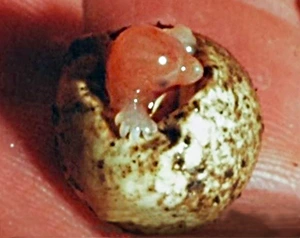
Photo: Echidna Baby hatching
Echidnas are unique egg-laying mammals called monotremes—the female lay eggs like lizards but feed their baby milk like a mammal. But the eccentricity doesn't stop there. The male echidna has a four-headed penis and the female echidna has two uteruses and no vagina! And it doesn't stop there. Both male and female echidnas have a pouch! They also have a cloaca which is a tube with a single opening that is used to urinate, defecate, and mate.
Male Echidna - 4 Headed Penis
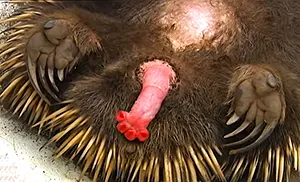
Photo: Echidna penis with four heads and pouch
The male echidna has a huge four-pronged penis, nearly a quarter of his body length when erect. This penis starts as a single shaft but splits into two, and these, in turn, split again, giving a total of four penis heads at the end of its penis. (see photo). However, the female echidna has only a paired uterus (see below), so the male uses only two penis heads at a time to inseminate a female. Additionally, echidna sperm cells work cooperatively, swimming together in bundles of up to 100 sperm to reach the egg. In humans, each sperm cell swims independently.
The male echidna only uses its penis for mating. It does not urinate through its penis like most other mammals. The male echidna also has no scrotum–its two testicles are inside its body near its kidneys. When not in use, the echidna neatly tucks its penis away inside its cloaca.
Female Echidna - No Vagina & Lays Eggs
The female echidna is a truly bizarre. It is an egg-laying mammal (mammals usually don’t lay eggs). She has two uteruses, that open into a single cloaca. She lays eggs like a reptile, but feeds its babies milk like a mammal—making her one of nature’s rare egg-laying mammals, known as monotremes. Unlike typical mammals, however, the echidna has no nipples. Instead, two small, circular milk-producing areas (areolae) secrete milk directly onto the skin. The baby, known as a puggle, laps up this milk while nestled safely in the mother's warm, fur-lined pouch.
Female echidnas are similar in appearance to male echidnas, with no noticeable external differences. Just like the male echidna, the female too has a pouch-like depression on its belly. But unlike the male, this pouch enlarges during the breeding season and has two small circular areas (areolae) that produce milk. It has no nipples or teats. This pouch is surrounded by hairs for the young to hold onto.
Echidna - Reproduction
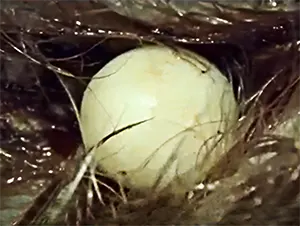
Photo: Echidna egg
Echidnas are solitary animals. The only time they socialise is between June and September, when female echidnas are receptive to advances from males. Up to 11 males echidnas form a line, sometimes referred to as a 'love train', and follow a female around for extended periods and try to mate with her. Usually, the successful suitor is the male who endured the longest and stuck closest to her.
Echidnas are promiscuous. They mate with as many partners as possible. They copulate by lying on their sides with their spineless undersides facing each other. The male penis is extended out of its cloaca and inserted into the female cloaca for impregnation.
After fertilisation, the female begins to develop a temporary pouch which is essential a depression in her abdomen with contracting muscles, which forms a pouch-like fold. In the meantime, the fertilised egg develops first in an oviduct and then in a uterus. Approximately 16 days after fertilisation, the female echidna lays a single leathery egg, roughly the size of a small grape weighing s 1.5 to 2 grams. Nobody knows for sure how she does this. Some suggest that she collects the egg as it comes out of her cloaca and deposits it into her pouch. Another more likely scenario is that she curls up into a shape like the letter “C” and deposits the egg from her cloaca directly into her pouch. She then incubates the egg in her pouch for a further 10 days.
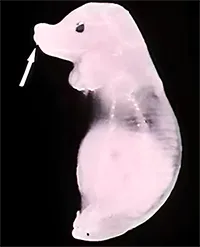
Photo: Echidna baby’s eye-tooth
On about the tenth day the young echidna, referred to as a puggle, uses its eye-tooth (another example of its reptilian ancestry) to tear through its leathery shell and exists into the pouch. At this stage, it has well-developed forelimbs and is about the size of a small jelly bean. The puggle uses its forelimbs to hold onto fur in its mother's pouch.
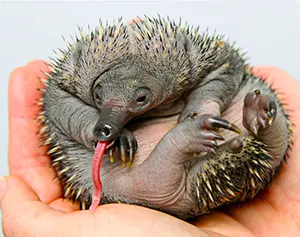
Photo: Echidna baby called a puggle
The mother echidna has no nipples or teats like other mammals. Instead, it oozes milk through its skin from specialised milk patches. The puggle nuzzles up against these patches, which encourages them to secrete milk which the puggle licks up rapidly.
The baby puggle stays in its mother's pouch for about 3 months. During this time, the female may remove the puggle from its pouch and leave it in a special nursery burrow while she goes out to forage for food. Once the puggle's spines have begun to develop, its mother encourages its offspring to spend more and more of its time outside the pouch. Finally, when the puggle is about 200 days old, the mother digs out its nursery burrow opening and leaves the young puggle to fend for itself.
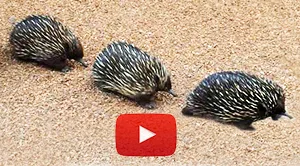 Read More
Read More